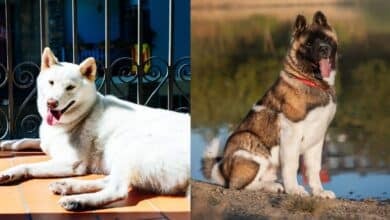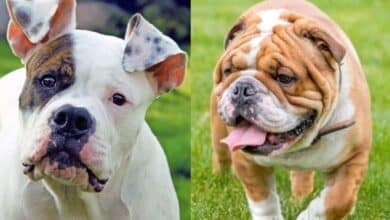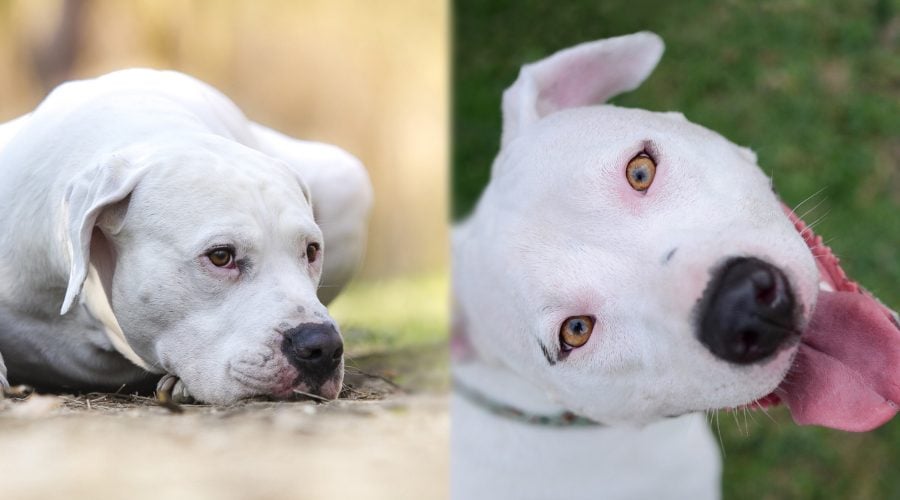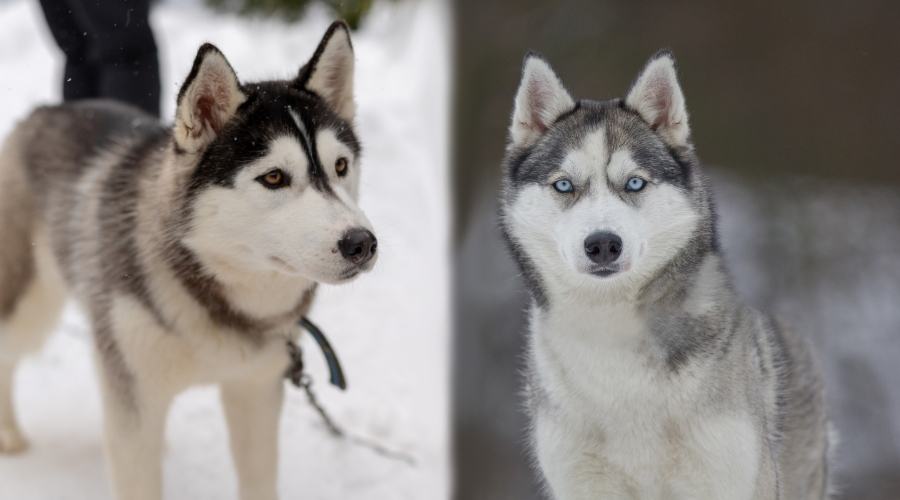Australian Cattle Dog vs Blue Heeler: Differences & Similarities
When you purchase through links on our site, we may earn a commission. Here’s how it works.
Are you curious about the similarities and differences between the Australian Cattle Dog and the Blue Heeler? There is a lot of speculation about Blue Heelers being different from Australian Cattle Dogs. But you might be surprised to learn that the Australian Cattle Dog and the Blue Heeler are the same dog breed. There is only one difference between them: Aussie Cattle Dogs have a blue or red coat, whereas Blue Heelers are only blue.
Table of Contents
The breed name is Australian Cattle Dog, and they come in two color varieties, blue and red. Aussie Cattle Dogs are sometimes called Heelers because their herding technique is nipping the heels of the cattle. So, a Blue Heeler is just a nickname for a blue-colored Australian Cattle Dog. And red-colored Aussie Cattle Dogs are sometimes called Red Heelers.
We explore their history and explain how the Blue Heelers nickname came to be. We also look at their appearances, personalities, grooming requirements, puppy prices, and more. They are the same dog breed and almost identical, but there is one slight difference between them. So, let’s take a closer look at the Australian Cattle Dog vs. the Blue Heeler in more detail.
Breed Comparison
- Height17-20 inches
- Height17-20 inches
- Weight35-50 pounds
- Weight35-50 pounds
- Coat ColorBlue or Red
- Coat ColorBlue
- TemperamentLoyal, intelligent, tenacious
- TemperamentLoyal, intelligent, tenacious
- EnergyExtremely High
- EnergyExtremely High
- HealthAbove Average
- HealthAbove Average
- Lifespan12-16 years
- Lifespan12-16 years
- Puppy Prices$1,000+
- Puppy Prices$1,000+
Breed History
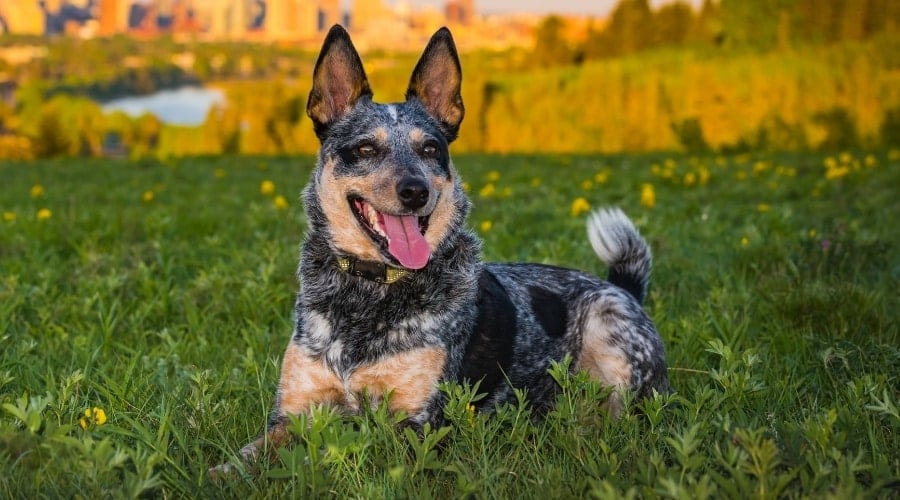
The Australian Cattle Dog’s history began when Anglo-Australian settlers found that their herding dogs were no match for Australia’s harsh terrain and scorching weather. They needed to create a sturdy pooch to herd their cattle and thrive in their new conditions. So, the settlers bred their Smithfield dogs with domesticated Dingos. Dingos are wild dogs from the Australian Bush, so they were the prime canine candidate to cope with the harsh climate.
The settlers later bred these dogs with Dalmatians to introduce a protective streak and the familiarity of working alongside horses. It is thought that they also used the Scottish Highland Collie to perfect their herding skills, including the famous heal nipping techniques. The result was the new Australian Cattle Dog. One of the critical players in this breeding process was a man named Thomas Hall. This is where the breed’s nickname, “Hall’s Heelers,” originates.
Cattle dogs became instantly popular as a working breed on ranches. Thanks to their herding skills and tireless work ethic, they’ve played a massive part in America’s beef industry. In recent years, they’ve begun to find their way into active family homes as companion dogs. For as long as Australian Cattle Dogs have been around, so have Blue Heelers.
Appearance
Australian Cattle Dogs and Blue Heelers are strong and compact with squareish frames. They weigh between 35 and 50 pounds and measure between 17 and 20 inches from paw to shoulder. Females are generally smaller than their male counterparts. Their eyes are oval and usually dark brown, although some have different colored eyes due to the heterochromia gene. Like a fox’s tail, their tails are always low-hanging, straight, and bushy.
Coat & Colors
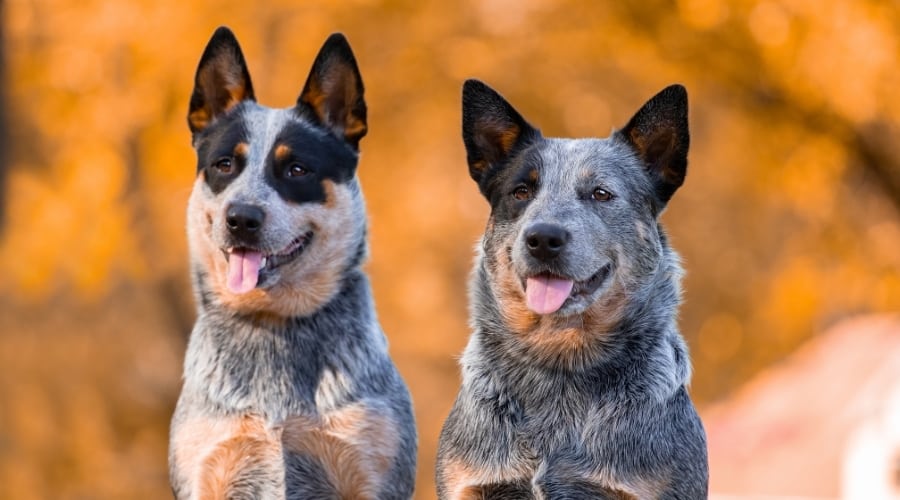
Australian Cattle Dogs and Blue Heelers have a smooth, double coat with a short, dense undercoat. The outer coat is straight, hard in texture, and flat, making it weather-resistant to the rain and sun. Their double coat sheds heavily during the shedding seasons and light to moderate throughout the rest of the year.
This is the only aspect where you see a difference between Australian Cattle Dogs and Blue Heelers.
The Australian Cattle Dog breed standard states that there are five acceptable colors:
- blue
- blue mottled
- blue speckled
- red speckled
- red mottled
Any dog can also have tan, red, or black and tan markings. So the only difference between these two dogs is that Australian Cattle Dogs can be any of these colors, whereas Blue Heelers are only ever blue. In the same way, Cattle Dogs with a red coat are sometimes called Red Heelers.
Temperament
Despite what some people claim, there is no difference in the temperament between an Aussie Cattle Dog and a Blue Heeler. Sure, all dogs are different and have slightly different personalities. But overall, they are all very similar. They are highly intelligent and rank as the tenth most intelligent dog breed, according to Stanley Coren’s famous study, “The Intelligence of Dogs.” They are loyal and extremely keen to impress their master.
Australian Cattle Dogs and Blue Heelers have one of the strongest work ethics in the world. Combine this with their tireless energy levels, which is why they make great companions for cattle ranchers. This is why they only do well with highly active families and can be too demanding for the average family home. It’s essential to consider whether you have the time, patience, and energy to keep up with one of these pups.
Aussie Cattle Dogs and Blue Heelers have a protective streak and defend their human pack and home without stuttering. They are aloof and can take a Like German Shepherds, they are affectionate and bond closely to their primary caregiver. Their loyalty and constant need to be with their humans means they can be too much for some families. These dogs hate being left alone for too long and can be very destructive when anxious.
Exercise
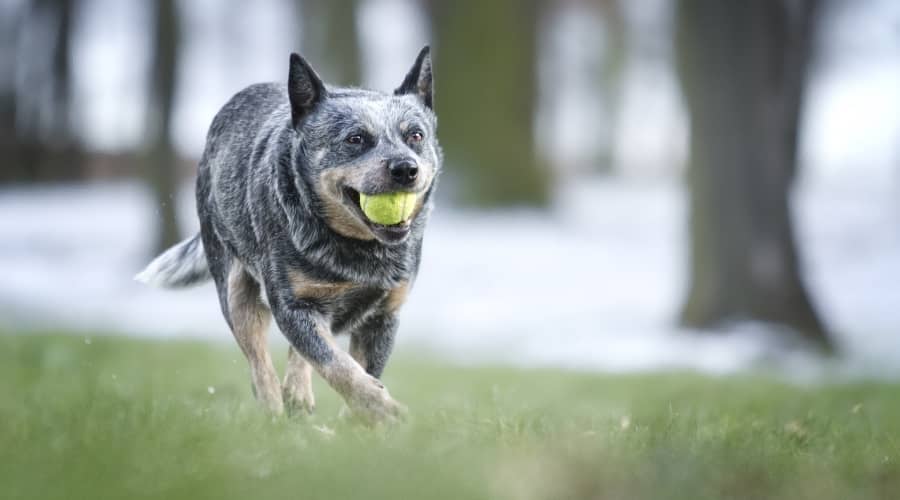
Australian Cattle Dogs and Blue Heelers are among the most energetic dog breeds. They both need at least 90 minutes of exercise daily, and it has to be intense activity to satisfy their energy needs. Neither of these dogs is satisfied with simple strolls around the neighborhood. Think herding, doggy agility courses, mountainous hikes, marathon runs, etc. Their high energy needs are one of the main reasons many are returned to the breeder or shelters because families don’t realize how much stimulation they need.
You must provide them both with plenty of challenging and tough dog toys. When they don’t get enough exercise or are left to their own devices, they can become very destructive and sometimes behaviorally problematic. They ruin furniture, dig up yards, and shred clothes. And they start to herd their family and other pets, including nipping at people’s heels. Living with an unhappy Cattle Dog or Blue Heeler can be challenging and unattainable.
Training
Like many working dogs, Australian Cattle Dogs and Blue Heelers are very independent and stubborn. Sure, they are very intelligent and trainable, but sometimes they are too smart for their own good. These dogs need an experienced dog owner and trainer to get the best out of them. If they feel you are too weak as a master, they might ignore you completely. Many Cattle Dog or Blue Heeler owners hire professional dog trainers, like Doggy Dan, to get the best out of their dogs.
It’s crucial to socialize these breeds from a young age. Otherwise, they might become overprotective or nervous about their surroundings. Crate training is essential for this breed because you have to leave them alone at some point. So you want to know they are safe and cannot destroy your home when you are out. Picking a tough crate is crucial for these energetic dogs.
Health
Australian Cattle Dogs and Blue Heelers are very healthy, with long lifespans between 12 and 16 years. You must stay up-to-date with vaccinations, treatments, and health checks to keep them healthy. You also need to provide them with lots of stimulation, activity, and high-quality nutrition. If you notice anything wrong with your dog, you must get them in with your vet immediately.
Like all breeds, they are predisposed to some health concerns, so it is important to consider pet insurance to help offset unexpected and sometimes ongoing healthcare costs.
Cattle Dogs and Blue Heelers are prone to the same health concerns. These include deafness, joint dysplasia, and several eye conditions, such as progressive retinal atrophy. When working with a breeder, ask to see the relevant health certificates so you know they come from a healthy breeding stock.
Nutrition
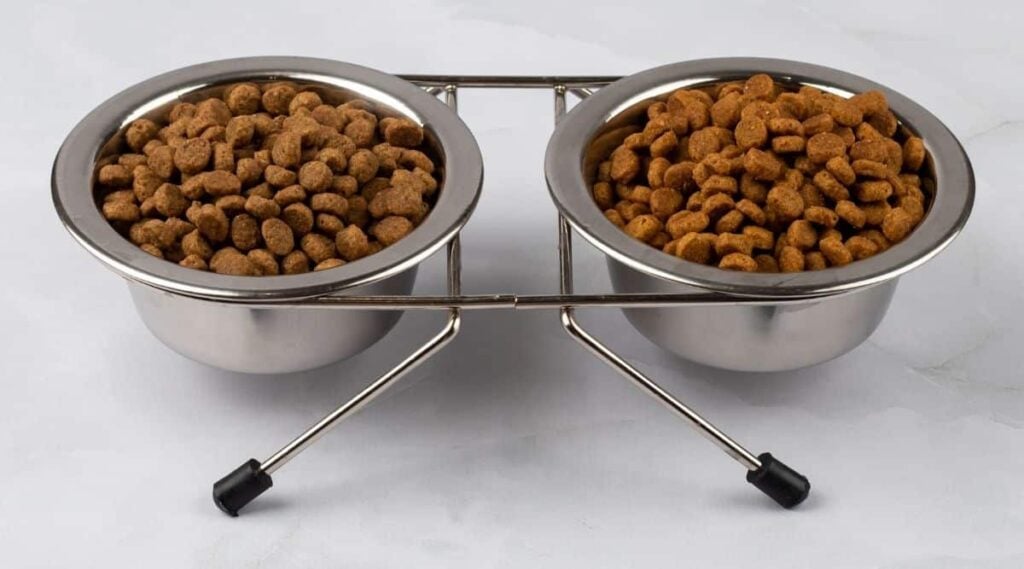
Australian Cattle Dogs and Blue Heelers are very energetic and constantly on their paws, so you might expect their food intake to be high. But they surprisingly only need around two to three cups of food daily. How much you feed them depends on various factors, such as their age, size, activity levels, and the diet you provide them. Be sure to follow the feeding instructions to determine the right amount of food for your dog.
It’s essential to feed them both an age-appropriate diet, especially during their developmental puppy stage, as it helps to control healthy growth. As they are very active, a high protein and energy-rich diet is beneficial, especially if they are working dogs.
Grooming
Regarding grooming, Australian Cattle Dogs and Blue Heelers have a relatively simple schedule. They only need brushing once a week to get rid of the dead hair and dust they collect on their adventures. They have a double coat that sheds moderately all year round and heavily during the shedding seasons. A bristle brush is ideal for use all year round, with a deshedding tool for the shedding season.
Both dogs only need bathing once every two to three months. Unless, of course, they get super mucky on the ranch or their travels. They also need their teeth brushing regularly to prevent periodontal diseases. Start their grooming regime young, and they should grow up to enjoy this bonding time with you.
Puppy Prices
The price of an Australian Cattle Dog or Blue Heeler from a reputable breeder is typically in the region of $1,000. Expect to pay a little more if you want a puppy from an award-winning bloodline or popular breeder. It’s essential to research the breeder before committing to a puppy. Please ensure they are responsible and care for the puppies and parents. Meet them in person and ask for the relevant health certificates. Breeders might ask you many questions to ensure your suitability for these breeds.
If you find a Cattle Dog or Blue Heeler for much less than this, chances are the breeder is irresponsible or part of a puppy mill. Please make yourself aware of their tactics and avoid them at all costs. Regarding everything else puppies need, the Cattle Dog and Blue Heeler cost roughly the same. Remember to purchase everything they need, such as good-quality dog beds and other supplies.
Final Thoughts
Now you know that Australian Cattle Dogs and Blue Heelers are the same dog breed with different colored coats. They have the same personalities and incredibly high exercise needs. Their grooming requirements are relatively simple, and they need an experienced master to get the best out of them. But if you can meet their needs, Aussie Cattle Dogs and Blue Heelers are incredible canines on the ranch and at home.
